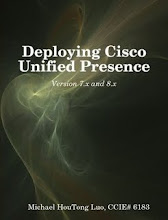However, CUPS and CUPC are more like peers. They were designed by two different groups of developers. These two groups treat each other as an "important customer", but not the only customer.
For example, CUPS can be used without CUPC.
Example #1: MOC RCC (Microsoft Office Communicator Remote Call Control).
MOC can control an IP Phone via CUPS and CUCM without CUPC in the picture.
Example #2: SIP Proxy
CUPS acts as a SIP proxy without CUPC in the picture.
Example #3: IPPM (IP Phone Messenger)
An IP phone can see buddy's status, send IMs, retrieve meeting schedules without CUPC in the picture.
On the other hand, CUPC was built as a multi-function software other than just a "CUPS client".
Right now, CUPC can't function without CUPS. Because it uses CUPS as a configuration repository. CUPC has to retrieve the configuration from CUPS for all its features. But except for the presence feature, all other features do NOT rely on CUPS.
For example, CUPC's soft phone feature is most demanded from Mac OS users. It's the only Cisco soft phone works on Mac OS. (CIPC - Cisco IP Communicator does not run on Mac). However, to use CUPC, you need a CUPS server. In this scenario, CUPS server provides no value other than supplying the TFTP address to CUPC. If CUPC can save the TFTP address locally (like CIPC), there's no need for CUPS server. It makes perfect sense from both technical and economic perspective.
Same for other CUPC features like Voicemail, Web Conference, LDAP search, click to dial, etc.
For this reason, CUPC developers are considering the options of "separating CUPC from CUPS" and make them more independent to each other.
With that said, CUPC and CUPS are more like peers other than father and son (or couple). Keep that in mind would help you understanding the function modules of CUPC.


You mentioned that CUPC is the only Cisco softphone that can run on Mac PCs. The question is: is the CUPC toolbar for Outlook supported on Mac PCs too?
ReplyDeleteThanks
Francesco
No. It is not supported on Mac. :(
ReplyDeleteHi, this is a great blog! Do you know if the CUPC softphone will work with a Microsoft VPN?
ReplyDeleteThanks,
Bill
Soft Phone works over SIP/TCP. It doesn't care if it's VPN or not. As long as the network can pass through SIP packets.
ReplyDeleteMichael
Hello Michael,
ReplyDeleteThanks for this amazing review! I had a few follow up questions that would be great if you could provide some insight:
1) You mention that the cupc client needs the cups server only to give it the tftp address and I am guessing this TFTP server would hold its config?
Can this TFTP server be the CUCM?
2) Is it possible to provide the CUPC with the TFTP address without having the CUPS server?
The reason I am asking this is to see if it is possible to use the CUPC as a standalone SIP client on the CUCM with the basic call functionality (calls, transfers etc) without having the CUP server. Do you think that is possible now?
Any insight would be great!
Thanks in advance,
Kamran
Yes, the TFTP address is usually the CUCM address.
ReplyDeleteNo, you cannot feed the TFTP address to CUPC without a CUPS server.
RE: "For this reason, CUPC developers are considering the options of "separating CUPC from CUPS" and make them more independent to each other."
ReplyDeleteMichael, have you heard anything further about Cisco's CUPC developers making CUPC independent from CUPS?
Also, are you aware of whether the Cisco Unified Mobile Communication requires CUPS or can it work directly with CUCM?
Thanks!
CUPC requires CUPS. CUMC requires CUMA. No plan to make CUPC or CUMC independent yet. :)
ReplyDeleteIs there any password recovery process for CUPS?
ReplyDeleteRaj
Same as CUCM.
ReplyDelete